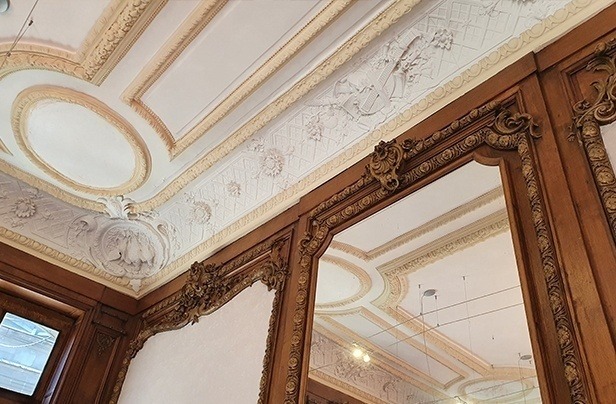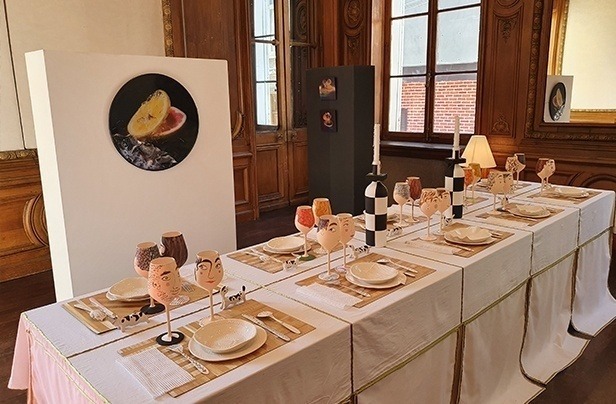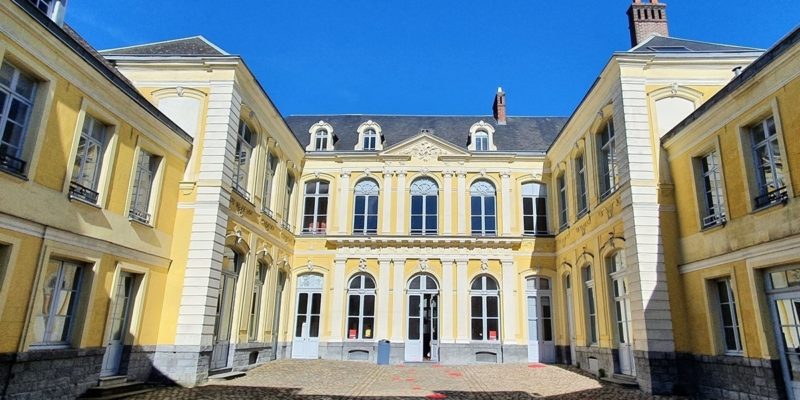The Hôtel de Guînes, located in the center of Arras (Rue des Jongleurs between the Abbaye Saint Vaast and the théâtre square), is one of the city’s cultural landmarks, where you can easily see various art exhibitions throughout the year. A private mansion built in 1738 on the initiative of the Comte de Bonnières, it resembles the Parisian models with courtyard and garden, as do other residences such as the Hôtel Dubois de Fosseux (1749) a few hundred meters away on the way to the administrative center, and is where the Guînes family stayed when they were in town. Its remarkable facades are listed, as are the rooms with their stuccoed ceilings.

Stucco ceilings at the Hôtel de Guînes
Location in Arras
Here is the map leading to 2 Rue des Jongleurs in Arras :
What we can see of the Hôtel de Guînes
As you enter the courtyard, you’re immediately struck by the classical-style facades and the cobblestones typical of the period beneath your feet. The wall compositions are symmetrical and the decorative repertoire is inspired by antiquity. In the main hall of the main building at the far end of the courtyard, a few steps lead up to rooms of impressive heights, typical of the period. Admire the floors, walls and ceilings (as well as the marble fireplaces) when you take the time to stroll through an art exhibition.

Art exhibition at the Hôtel de Guines in Arras
Who was the de Guînes family in Arras?
The Guînes family was a noble family of the Ancien Régime. The Guînes family were Counts of the eponymous town in the Pas-de-Calais region, near the sea in the Opal country. Even today, the town is renowned for its forests and marshes, and remains a tourist attraction despite its small population (just over 5600). But in reality, it was Charles Eugène Jean Dominique de Bonnière who added the name Guînes. He was Count of Souastre. The man behind the building that can be admired in Arras was none other than Adrien Louis de Bonnières, the Comte de Souastre who became Duc de Guînes. He was born in Lille on April 13, 1735 and died in Paris on December 21, 1806. A French soldier and diplomat of the XVIIIᵉ century, deputy of the nobility to the States of Artois and Count of Souastre , the Duc de Guînes remained famous as a protégé of the Queen. A frequent court guest, Mozart even composed a concerto for flute, harp and orchestra for him.
From the Guînes affair to the Terror
A disgraced ambassador to Berlin in 1768, he became ambassador to London in 1770, where he was caught up in a scandal known as the “Affaire de Guînes” (a story of money and speculation on public funds involving the swindling of several Parisian bankers). Although Marie-Antoinette took her side in the affair, he was actually named “Duc de Guînes” on his return to Paris. He went on to win a string of noble titles, becoming knight of the Order of the Holy Spirit, governor of Maubeuge and finally governor of Artois in 1788. Fleeing the Terror to England, he returned to France during the Consulate and died in 1806. His coat of arms is “Vairé d’or et d’azur”.
X.D.
